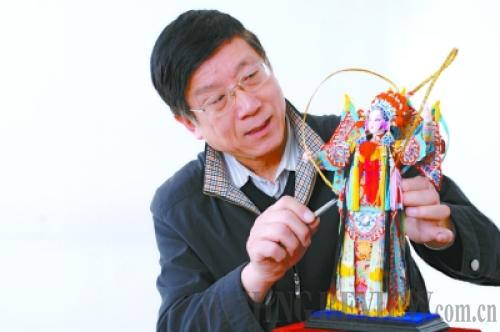|
 |
|
DEVOTION: Hua Shulin exhibits one of his hand-made silk figurines (CHINA CULTURE DAILY) |
Silk figurine is an art form of soft sculpture that originated in China during the Tang Dynasty (618-907). Making one of the figurines requires the use of iron wire, cotton, gauze as well as satin and natural silk. The dolls are typically fashioned after characters from popular Chinese folk stories and legends.
The art form was added to the list of crafts under Beijing's Municipal Level Intangible Cultural Heritage in 2009. Craftsman Hua Shulin was chosen to be the inheritor for silk figurines in Beijing.
A source of inspiration
Born in 1950, Hua had been working as a technical director at the Beijing Silk Flower Factory before he was appointed president of the Beijing Silk Handicraft Factory in 1983. It was in this handicraft factory that he began his dedication to traditional silk figurines, which some have even called "Chinese Barbies."
In the 1980s, masters of silk craftwork such as Yang Naihui and Wang Tianfeng were working at Hua's factory. Both of them were pupils of late Ge Jing'an (1905-unknown), who created the Beijing-style silk figurine in 1945 and assembled a team to help manufacture them in the 1950s.
Under the artistic influence of these two masters of the art form, Hua gradually fell in love with silk figurines.
To save the factory from financial loss, Hua proposed that they should reform and innovate their designs in order to improve the quality and diversify the range of products that they manufactured. In order to attract more talented craftsmen to his factory, he held design competitions and held exhibitions of the most outstanding examples.
Experts including Ge had been invited to the exhibitions and were impressed by the works on display. One of the guests said to Ge during their visit, "I see the hope of a revival for silk figurines here."
Hua was greatly encouraged upon hearing this comment and knew that he must be on the right path.
"I suddenly felt a strong sense of responsibility and I told myself that I must pass on the craft of silk figurine making to others," Hua recalled.
In order to concentrate all his attention research and to the refinement of the art form, Hua left his position in 1987 and opened a silk figurine workshop. At this time he also started to learn under the guidance of Ge.
"She cared a lot about my career. She came to see me and helped me to refine and perfect my work at the hardest time, which was when I had just started my workshop. I feel indebted to her," Hua said.
In her last days, Ge revealed to Hua two unfulfilled wishes of hers: to publish a book on silk figurines and to set up a silk figurine museum. The dying woman gave Hua her script summarizing her experiences of silk figurine making and asked him to pass the ancient art form on after her passing.
"My teacher's last words are the inspiration for my work," Hua noted emotionally.
For dozens of years, Hua has been working on preserving and popularizing the art form. He has published two books, Beijing Silk Flower and Beijing Silk Figurine, with the assistance of government departments. His figurines based on the Chinese theatrical classic The Peony Pavilion and the literary classic Dream of the Red Chamber have been displayed at the Art Treasures Museum of the Chinese Nation in Beijing.
The future of the artform
It is never easy to learn a difficult craft such as the making a silk figurines. Especially one that entails sophisticated skills and more than ten separate stages including carving, painting, coloring, sewing, dyeing and gluing.
"These days people tend to be more fickle and fewer people would be willing to take up this craft," Hua noted.
Aside from the lack of willing students interested in learning the craft, the counterfeit silk figurine industry is another major concern for Hua. Fake figurines are made with inferior materials, as well as being put together with less care and attention to detail and thus are much cheaper than hand-made ones though similarly of far lesser quality.
"A genuine silk figurine takes a great deal of time and energy for the craftsman to finish. The survival of this art form is threatened by the counterfeits flooding into the market," Hua said.
Though faced with various difficulties, 63-year-old Hua is filled with confidence, "I will hold my teacher's words in my heart and pass on the craft, letting more people get to know and fall in love with silk figurines".
(Source: China Culture Daily) | 